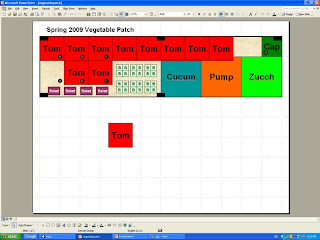I've recently noticed a lot of links to software designed to assist home gardeners to plan and manage their vegetable patch and garden beds. Some software is for free, others require some level of payment... at the very minimum, you will have to fill out a form and receive junk emails for the next few years of your life. My advice - don't do it. There are many easy workarounds to achieve the same result.
Since I started my vegetable patch, I've been using Microsoft Powerpoint to plan and manage the garden. Most readers will have access to Powerpoint, whether it's on the home computer, at work, or in the local library.
Once you've opened Microsoft Powerpoint, click on View > Grid and Guides. This will give you a view that resembles graph paper. Work out your scale, and draw up your garden/bed/patch using options presented in the drawing toolbar.
Before I plant out my patch for the upcoming season, I box out my desired crop. For example, I know that I should allocate one square metre for a single pumpkin plant. Using my chosen scale, I create squares that resemble the appropriate spacing for the vegetables I would like to plant.
Once all of my desired plants are pictured on the slide in Microsoft Powerpoint, I move them around until I find the most effective use of space in the vegetable patch, keeping in mind the direction of the sun, height of the plant, and previous crop rotations.

Pictured above is a possible spring vegetable patch. Note the different shapes representing each vegetable. The size depends on the spacing that each type of vegetable requires. The process is a bit like putting a jigsaw puzzle together. It not only maximises your bed's capacity and harvest, but it provides a great record of your changing garden bed through the years. I keep the slides for each season to assist in managing my crop rotations.
No comments:
Post a Comment